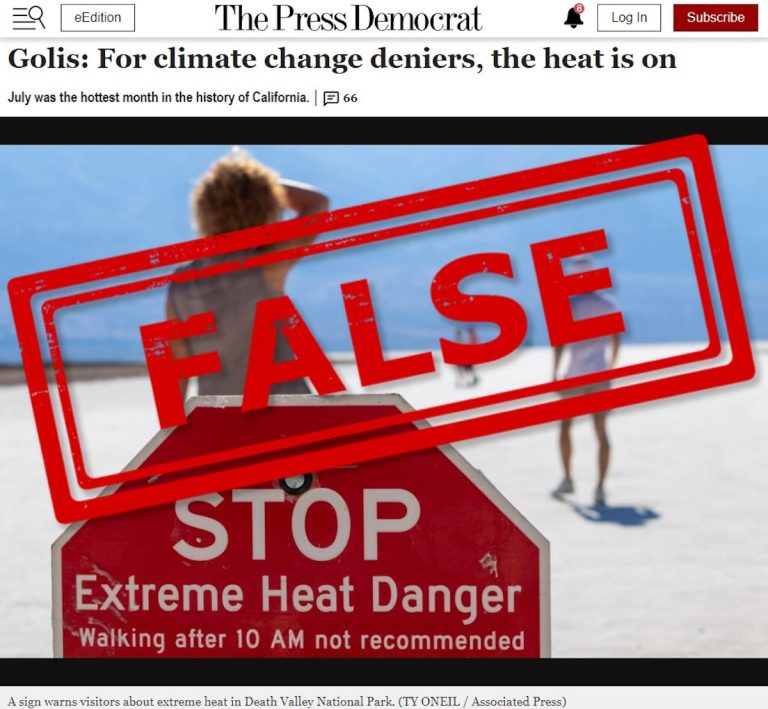
press democratThe Santa Rosa, Calif., newspaper of record published an op-ed in its Sunday, Aug. 18 edition titled, “Golis: For climate change deniers, the heat is on.” [emphasis, links added]
In addition to being reprehensible about climate change skeptics, this article is completely wrong in many ways.
Author Peter Golis made the classic mistake of conflating short-term weather timescales with long-term climate timescales and then incorrectly citing this as evidence of long-term climate change.
Here are some of the claims Golis makes in the article:
July is the hottest month on record in California.
We're not surprised. In July, the high temperatures in the 80s gradually ease, and the morning fog typical of summer disappears.
“July is hot not only because of its intensity…but also because of its duration,” UCLA climate scientist Daniel Swain wrote on his Weather West blog.
He added: “Temperatures have remained extremely high for several weeks and have not cooled significantly at night…”
The article went on to mention several temperature records in California cities:
Ukiah recorded a high temperature of 117 degrees, breaking the century mark, and temperatures over 100 degrees are common.
Palm Springs is no stranger to hot weather, recording its hottest day ever at 124 degrees.
Even Death Valley, one of the hottest places on earth, set an incredible new record. There were 24 days in July where the temperature exceeded 120 degrees, including a high of 129 degrees on July 7.
As a result, some new high temperature records were set in California, a traditionally hot place. In the context of climate change, this is not news.
It's worth noting that we only have about 150 years of accurate temperature records in California. We don't know what the highest July temperature was in California 200 years ago or earlier.
The emergence of new records is not surprising given the short-term data we compare to California's long-term geological presence.
In fact, California’s official temperature records began in Sacramento in 1877, according to the National Weather Service in Sacramento. While there were a few hot days in the summer of 2024, the overall data did not exceed historical measurementsas shown in their analysis below:

All this hand-waving by Golis turns out to have nothing to do with climate change.
The effects of climate change are on longer time scales, up to 30 years or more, while the effects of weather are on shorter time scales, from hours to days, sometimes lasting weeks. That's what we have here.
A high-pressure thermal dome pattern centered in California is causing temperatures to rise, Because it moves slowly, it causes persistent high temperatures. It's a weather pattern and nothing more.
Just days after Golis claimed climate change was responsible for California's hottest month on record, weather patterns changed, Temperatures are now below normal across much of California, with an increased chance of rainfall As shown below:

Compare the following NOAA maps from July to August. Note how California went from “above normal” to “below normal.”

Apparently, a shift in weather patterns occurs between July and August. This is not “climate change”, this is just normal weather.
Golis didn't know what he was talking about. He made it very clear because The rest of the article he wrote was mostly a political rant against the Republican Party and its energy policies.
He believes these policies are the root cause of hot weather and everything but the kitchen sink:
Death and destruction from heat and fires, rising sea levels, melting glaciers, torrential rains, the frequency of horrific storms – scientists say climate change will be defined by extreme weather that is more destructive than before.
Luckily, Mother Nature changed weather patterns to make it cooler than normal, and Golis ended up looking like a fool.
Unfortunately, editors and fact-checkers press democrat The Sunday when Golis’ climate rant was published, I didn’t bother looking at the cooling weather. In their presence, this column might have been more balanced and informed.
Read more Climate Realism
